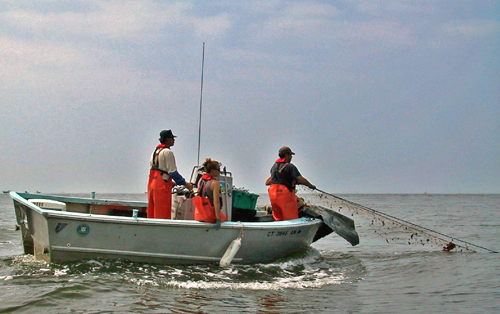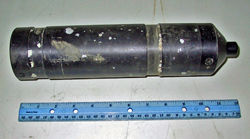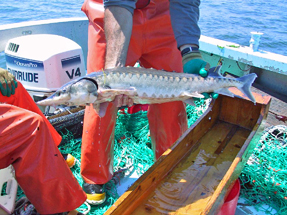Shortnose Sturgeon Research
Report your sighting via our online app.
To aid in the protection of the state's only endangered fish species (both State and Federal listing), Fisheries Division staff collect information on numbers, locations, movements and behavior of Connecticut River shortnose sturgeon. From 1988-1994, Division staff collected, tagged and released 325 shortnose sturgeon. Data from recaptured fish were used to estimate the total population of adult (> 45 cm) shortnose sturgeon at approximately 850 fish in the lower Connecticut River (between the Holyoke Dam in Massachusetts and the river mouth). In addition to the external carlin tag, 38 shortnose sturgeon were surgically implanted with ultrasonic transmitters so that their individual movements could be tracked over a 1-2 year period. Several concentration areas in the river were identified where sturgeon congregate year-round. Seasonal movements of fish between concentration areas were precisely mapped.

Sturgeon are known to be a very hardy, long lived (50-75 years) species, but their delayed maturity (first spawning at age 15-20), non-annual spawning , small adult population, and limited spatial distribution make them extremely vulnerable to further population decline, and at worst, possible local extinction. The Atlantic sturgeon, a much larger cousin of shortnose sturgeon and once a famous source of caviar that visits the state's larger rivers, is no longer believed to spawn in Connecticut.
Data obtained from ongoing sturgeon studies have proven invaluable to Fisheries Division staff who provide advisory comment to DEEP Bureau of Water Management and DEEP Office of Long Island Sound Programs staff when reviewing proposals to conduct projects that could be deleterious to the sturgeon population such as bridge demolition or dredging. Additional research and examination of the limiting factors defining each concentration area are necessary to fully protect the remaining population and enhance the probability that the species will still exist in the next century. These studies, however, are now funded only by a small onetime private grant; no funding is currently available from state or federal sources.
Atlantic Sturgeon Research
Connecticut DEEP Marine Fisheries is conducting a study of Atlantic sturgeon. We are interested in information you may have about the fish and want to let you know about our activities. We will be collecting the fish with skiff trawls and gillnets, usually from small boats (20 feet). Trawls are hauled by hand and tows usually last less than 10 minutes. Most gillnets are set for 4 hours or less around high slack tide, although you might see the occasional 24 hour set. All fish and invertebrates are counted but returned to the water. All sturgeon collected will be examined, measured and tagged.


A key component of our study will be the surgical implantation of ultrasonic transmitters into Atlantic sturgeon. These transmitters will send out depth and identification information every 60 seconds. Self-contained acoustic receivers (VR2’s) will be deployed in various areas to listen for and record the individual transmitters. Receivers will record information from all transmitters within listening range. Acoustic receivers (pictured below) will be anchored at key locations to record information. Receivers will be set in one of two methods, either listening from the bottom up or from the surface down. Upward listening VR2’s will be moored with mooring anchors, pot warp and pot buoys. Pot buoys will be labeled ‘CT DEEP Please do not disturb’. Downward listening receivers will be attached to USCG Navigational Aids with stainless steel cable or pot warp. Receivers have internal batteries that can last six months, but we will download data monthly to minimize loss of information if receivers are tampered with or lost. We ask that people do not disturb these receivers as they are not associated with, nor do they interfere with, any fishing or boating activity.
Atlantic Sturgeon Acoustic Telemetry Research Poster
For additional information, please contact Jacque Benway at the DEEP Marine Fisheries Division, 860-434-6043 or by email Jacque.Benway@ct.gov.
Content last updated May 2024

